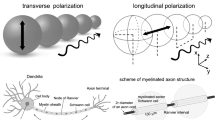Abstract
Isolated wave segments are a type of spatiotemporal activity that has been repeatedly reported in experimental studies of spreading depolarization on the cerebral cortex and retina of laboratory animals. However, it has been theoretically shown that such a pattern cannot be stable in a continuous excitable medium. In our work, we address this problem using the model of a discrete–continuous medium. We present the targeted numerical study of isolated wave segments, including scenarios of their emergence and an estimation of their stability to various deformations. We show that an isolated wave segment can exhibit the properties of a space-time attractor by cyclically changing its shape and approaching it from different initial conditions. Such a wave segment is not necessarily small, although small segments may occur more easily and are, therefore, more likely. Finally, we show that the behavior we found persists also under conditions of a heterogeneous propagation medium, which indicates the applicability of our findings to the analysis of spatiotemporal patterns in real nervous tissue.









Similar content being viewed by others
Data availability
This work has no associated data.
References
A.C. Charles, S.M. Baca, Nat. Rev. Neurol. 9, 637 (2013)
J.P. Dreier, C.L. Lemale, V. Kola, A. Friedman, K. Schoknecht, Neuropharmacology 134, 189 (2018)
K. Eikermann-Haerter, Headache 54, 1146 (2014)
A.A. Leao, J. Neurophysiol. 7, 359 (1944)
L.A.B.R.I. University of California, M.A.B. Brazier, Cortical excitability and steady potentials: relations of basic research to space biology. In Proceedings of the First Conference, 1961. Editor: Mary AB Brazier (University of California Press, 1963)
H.C. Tuckwell, R.M. Miura, Biophys. J. 23, 257 (1978)
H. Kager, W.J. Wadman, G.G. Somjen, J. Neurophysiol. 84, 495 (2000)
B.E. Shapiro, J. Comput. Neurosci. 10, 99 (2001)
G. Somjen, H. Kager, W. Wadman, J. Comput. Neurosci. 25, 349 (2008)
W. Yao, H. Huang, R.M. Miura, Bull. Math. Biol. 73, 2773 (2011)
H. Tuckwell, AIP Conference Proceedings, vol. 1028, pp. 46-64 (2008) 1028
M.A. Dahlem et al., Physica D Nonlinear Phenom. 239, 889 (2010)
E. Santos et al., NeuroImage 99, 244 (2014)
Z. Zheng, J. Luo, Z. Cao, S. Tan, J. Lv, J. Stroke Cerebrovasc. Dis. 31, 106476 (2022)
M. Dahlem, E. Chronicle, Prog. Neurobiol. 74, 351 (2004)
M.A. Dahlem, S.C. Müller, Annalen der Physik 13, 442 (2004)
M.A. Dahlem, N. Hadjikhani, PloS One 4, e5007 (2009)
M.A. Dahlem et al., Front. Comput. Neurosci. 9, 29 (2015)
V. Zykov, K. Showalter, Phys. Rev. Lett. 94, 068302 (2005)
A. Kenny, M.J. Plank, T. David, J. Theor. Biol. 472, 11 (2019)
P.A. Arroyo, S. Alonso, R.W. dos Santos, Phys. Rev. E 97, 032214 (2018)
S.A. Neymotin et al., Neural Comput. 27, 898 (2015)
C. Iadecola, Neuron 96, 17 (2017)
D. Postnov, F. Müller, R. Schuppner, L. Schimansky-Geier, Phys. Rev. E 80, 031921 (2009)
D. Postnov, D. Postnov, L. Schimansky-Geier, Brain Res. 1434, 200 (2012)
A. Verisokin, D. Verveyko, E.A. Kuryshova, D. Postnov, Chaos 28, 106326 (2018)
E. Syková, C. Nicholson, Physiol. Rev. 88, 1277 (2008)
J. Tønnesen, V.K. Inavalli, U.V. Nägerl, Cell 172, 1108 (2018)
P.E. Kloeden, E. Platen, J. Stat. Phys. 66, 283 (1992)
M. Khodabin, M. Rostami, Adv. Differ. Equ. 2015, 1 (2015)
C. Rackauckas, Q. Nie, Discrete and continuous dynamical systems. Ser. B 22, 2731 (2017)
D.E. Postnov, D.D. Postnov, R. Zhirin, The “AGEOM_CUDA” software for simulation of oscillatory and wave processes in two-dimensional media of arbitrary geometry on the basis of high-speed parallel computing on graphics processing unit technology CUDA, RF registration certificate #2012610085 from 10.01.2012. (in Russian) (2012)
F. Kneer, E. Schöll, M.A. Dahlem, New J. Phys. 16, 053010 (2014)
N. Akhmediev, A. Ankiewicz, Dissipative Solitons: From Optics to Biology and Medicine (Springer, New York, 2008)
M. Yu et al., Nat. Commun. 8, 1 (2017)
R. Metzler, A.V. Chechkin. arXiv:2204.01048 (2022)
V. Zykov, Eur. Phys. J. Spec. Top. 157, 209 (2008)
V. Zykov, E. Bodenschatz, New J. Phys. 16, 043030 (2014)
V.S. Zykov, E. Bodenschatz, Phys. Rev. E 97, 030201 (2018)
J. Keener, Siam J. Appl. Math. 47 (1987)
T. Erneux, G. Nicolis, Physica D Nonlinear Phenom. 67, 237 (1993)
A. Hagberg, E. Meron, Phys. Rev. E 57, 299 (1998)
G. Fáth, Physica D Nonlinear Phenom. 116, 176 (1998)
N. Kouvaris, T. Isele, A. Mikhailov, E. Schöll, EPL 106, 68001 (2014)
M. Dahlem, T. Isele, J. Math. Neurosci. 3, 7 (2013)
Acknowledgements
This research was supported by the Russian Science Foundation, project #22-15-00143 (sections 1, 2.1, 3.3, 3.4, 3.5, 4), and by the government of the Russian Federation, project #075-15-2022-1094 (sections 2.3, 3.1, 3.2,4).
Author information
Authors and Affiliations
Corresponding author
Additional information
Brain Physiology Meets Complex Systems. Guest editors: Thomas Penzel, Teemu Myllylä, Oxana V. Semyachkina-Glushkovskaya, Alexey Pavlov, Anatoly Karavaev.
Supplementary Information
Below is the link to the electronic supplementary material.
11734_2023_810_MOESM1_ESM.pdf
The following supporting information can be downloaded at https://doi.org/10.5281/zenodo.7576597: program code for the implementation of the model, video examples of the solutions of the proposed model that demonstrate the scenarios of SWS emergence and the Matlab code for the implementation of the cellular automaton. (PDF 156 KB)
Below is the link to the electronic supplementary material.
Rights and permissions
Springer Nature or its licensor (e.g. a society or other partner) holds exclusive rights to this article under a publishing agreement with the author(s) or other rightsholder(s); author self-archiving of the accepted manuscript version of this article is solely governed by the terms of such publishing agreement and applicable law.
About this article
Cite this article
Verisokin, A.Y., Verveyko, D.V. & Postnov, D.E. Isolated wave segments in a neural tissue model with volume transmission: discreteness matters. Eur. Phys. J. Spec. Top. 232, 499–508 (2023). https://doi.org/10.1140/epjs/s11734-023-00810-y
Received:
Accepted:
Published:
Issue Date:
DOI: https://doi.org/10.1140/epjs/s11734-023-00810-y



